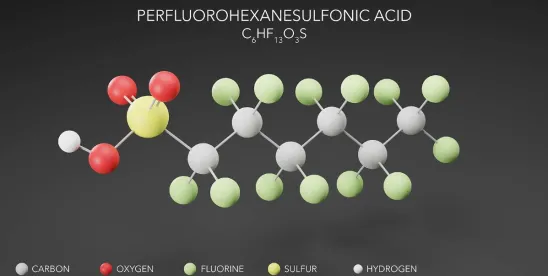On May 8, 2024, the United States Environmental Protection Agency (“EPA”) published its final rule designating two types of per- and polyfluoroalkyl substances (“PFAS”) — specifically, perfluorooctanoic acid (“PFOA”) and perfluorooctanesulfonic acid (“PFOS”), along with their salts and structural isomers, as “hazardous substances” under the federal Comprehensive Environmental Response, Compensation, and Liability Act (“CERCLA”). PFAS, also known as “forever chemicals” because they are persistent in the environment, are a group of manmade chemicals widely used historically in a broad range of industrial processes and consumer products, including textiles, cosmetics, cookware, food packaging and firefighting foam.
This rule will become effective on July 8, 2024.
Backdrop.
The EPA Council, established by the EPA in April 2021, released a PFAS Strategic Roadmap in October 2021, which included timelines for actions to be undertaken between 2021 and 2024 to better understand PFAS risks, prevent PFAS from impacting human health and the environment and broaden and accelerate PFAS remediation. The EPA’s rulemaking to designate PFOA and PFOS as CERCLA hazardous substances follows other recent EPA activity concerning PFAS, including issuing a final rule establishing national drinking water standards for six types of PFAS and issuing Interim Guidance on the Destruction and Disposal of PFAS for public comment.
Ramifications of the Rulemaking.
By designating PFOA and PFOS as CERCLA hazardous substances, facilities that release a reportable quantity (one pound)[1] of PFOA or PFOS within a 24-hour period will need to immediately report that release.
Releases of PFOA and PFOS will now be subject to the EPA response actions, without first requiring the EPA to find that the release (or threat of release) “may present an imminent and substantial danger.” The EPA can now require responsible parties to conduct and pay for the investigation and cleanup actions related to a release of PFOA and PFOS, or to reimburse the EPA for costs incurred if the EPA conducts those investigation and cleanup activities on its own.
However, the rule does not change the liability protections afforded under CERCLA[2] and does not automatically require any investigation or cleanup actions by the EPA or a responsible party. The EPA has had and will continue to have broad discretion under CERCLA to determine whether a response action is warranted.
On April 19, 2024, the EPA issued a non-binding PFAS Enforcement Discretion and Settlement Policy Under CERCLA (the “Policy”) describing how the agency intends to use its discretion in pursuing enforcement and settlement for PFOA and PFOS releases. According to the Policy, the EPA intends to focus on “parties that have played a significant role in releasing or exacerbating the spread of PFAS into the environment, such as those who have manufactured PFAS or used PFAS in the manufacturing process, and other industrial parties.”[3] For purposes of the Policy, the EPA refers to these parties as “major PRPs” (potentially responsible parties).[4]
Under the Policy, the EPA expressly does not intend to pursue parties where equitable factors do not support seeking response actions or costs under CERCLA. To that end, the Policy states that the EPA does not intend to pursue community water systems and publicly owned treatment works, municipal separate storm sewer systems, publicly owned or operated municipal solid waste landfills, publicly owned airports, local fire departments, and farms where biosolids are applied to the land.[5] However, these parties will not have full immunity, as the EPA expressly noted that it will still have the ability to pursue these entities — and any other responsible parties — who, by their actions or inactions, significantly contribute to or exacerbate the spread of significant quantities of PFAS contamination.
For other parties, the EPA will consider the following equitable factors in determining whether to exercise its CERCLA enforcement discretion for a PFOA or PFOS release:
- whether the entity is a state, local, or Tribal government or performs a service that would otherwise be performed by government;
- whether the entity performs a public service role in providing safe drinking water; handling municipal solid waste; treating or managing stormwater or wastewater; disposing or arranging for the disposal of, or reactivating pollution control residuals; ensuring beneficial application of wastewater treatment process products; or performing emergency fire suppression services;
- whether the entity manufactured PFAS or used PFAS as part of an industrial process; and
- whether and to what degree the entity is actively involved in the use, storage, treatment, transport, or disposal[6] of PFAS.
According to the EPA, the designation of PFOA and PFOS will not result in the reopening of sites that have been removed from the National Priorities List (NPL). However, sites for which five-year reviews are being conducted under CERCLA to determine a remedy’s protectiveness may be subject to additional requirements to evaluate and address impacts and exposures from PFOA and PFOS.
Takeaways.
Parties who manufacture, process, use, handle, store, treat, transport or dispose PFOA or PFOS should evaluate their operations in light of this new rulemaking, as they may be vulnerable to the EPA enforcement as well as contribution actions from other responsible parties if the EPA considers them a “major PRP.”
From an environmental diligence perspective, potential impacts from PFOA and PFOS will need to be evaluated (it will no longer be optional) under the ASTM E1527-21 standard for Phase I Environmental Site Assessments to satisfy the “All Appropriate Inquiries” standard to qualify for certain liability protections under CERCLA.
Parties currently involved in the investigation and remediation of a Superfund site should be prepared to include PFOA and PFOS among the contaminants requiring investigation and remediation, which could result in added time and costs. In addition, PRPs already subject to an allocation of liability may seek to re-allocate those liabilities based on the inclusion of alleged PFOA and PFOS contributions and impacts.
The most appropriate methods for disposal of PFOA- or PFOS- impacted materials may change as the EPA continues to evaluate the safety and effectiveness of PFAS destruction and disposal technologies.
Many states have environmental liability statutes modeled after CERCLA. Parties should be aware of any applicable state law changes to include PFOA, PFOS or any other PFAS among the hazardous substances regulated under any state analog to CERCLA.
It is clear that PFAS has become a hot button topic for the regulatory community and the promulgation of additional legislation, including expansion of the types of PFAS to be covered thereunder on the federal, state and local levels, should be anticipated.
Footnotes
[1] Of note, the reportable quantity for PFOA and PFOS is lower than it is for many other CERCLA hazardous substances, which often ranges from 100 to 5,000 pounds.
[2] The statutory defenses to CERCLA liability, including for innocent landowners, bona fide prospective purchasers and contiguous property owners, and for de minimis and de micromis contributors under the EPA’s De Minimis/De Micromis Policies will still be part of the EPA’s analysis.
[3] The Policy, page 2-3.
[4] The Policy, page 3.
[5] While the EPA does not intend to pursue these types of entities, these entities must still report qualifying releases of PFOA and PFOS. See the Policy, page 10.
[6] Of note, as a result of the CERCLA hazardous substance designation, the Department of Transportation also will be required to regulate PFOS and PFOA as hazardous materials under the Hazardous Materials Transportation Act. However, although there are similarities between CERCLA and the federal Resource Conservation and Recovery Act ("RCRA") which governs the federal management and cleanup of hazardous waste facilities, the designation of PFOA and PFAS as a hazardous substance under CERCLA does not automatically make PFOA- or PFOS-contaminated waste a hazardous waste or a hazardous constituent under RCRA. In February 2024, the EPA released two proposed RCRA regulations, one of which would add nine types of PFAS to the list of RCRA hazardous constituents for consideration in RCRA facility assessments.
William C. West also contributed to this article.



 />i
/>i

